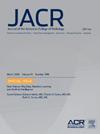Insurance-Based Differences in Treatment Patterns for Uterine Fibroids
IF 4
3区 医学
Q1 RADIOLOGY, NUCLEAR MEDICINE & MEDICAL IMAGING
引用次数: 0
Abstract
Purpose
The aim of this study was to examine whether Medicaid versus commercial insurance and reimbursement are associated with uterine artery embolization (UAE) utilization rates for uterine fibroid treatment.
Methods
This retrospective (October 2015 to September 2023) study of women aged 30 to 59 years who underwent procedures for the treatment of uterine fibroids (hysterectomy, myomectomy, or UAE) was based on the Inovalon Insights dataset for those with Medicaid or commercial insurance. Differences in the receipt of UAE versus hysterectomy or myomectomy by insurance type and relative reimbursement were assessed using logistic regression controlling for patient characteristics and geographic differences in treatment patterns. For women with either hysterectomy or myomectomy, differences in the receipt of these procedures laparoscopically or not were assessed by insurance type and relative reimbursement controlling for patient characteristics and geographic differences in treatment patterns.
Results
Medicaid compared with commercial insurance was associated with 38% higher odds of UAE (odds ratio [OR], 1.38; 95% confidence interval [CI], 1.34-1.42). States with higher Medicaid reimbursement for hysterectomy were associated with lower odds for UAE (OR, 0.95; 95% CI, 0.92-0.98). For women with hysterectomy or myomectomy, those with Medicaid versus commercial insurance had 20% lower odds (OR, 0.80; 95% CI, 0.79-0.82) of undergoing the procedure laparoscopically.
Conclusions
Women insured by Medicaid versus commercial insurance were more likely to undergo the less invasive UAE procedure. Conversely, Medicaid patients who underwent hysterectomy or myomectomy were less likely to undergo the procedure laparoscopically. Both results are consistent with the notion that insurance status may influence both physician referral patterns and treatment options available to patients.
基于保险的子宫肌瘤治疗模式差异。
目的:探讨医疗补助与商业保险和报销是否与子宫动脉栓塞(UAE)治疗子宫肌瘤的使用率相关。方法:这项回顾性研究(2015年10月至2023年9月)对30-59岁接受子宫肌瘤(子宫切除术、子宫肌瘤切除术或UAE)治疗的女性进行,研究基于Inovalon Insights, LLC的数据集,数据集中有医疗补助或商业保险的女性。通过logistic回归控制患者特征和治疗模式的地理差异,评估UAE与子宫切除/子宫肌瘤切除术在保险类型和相对报销方面的差异。对于子宫切除术或子宫肌瘤切除术的妇女,通过保险类型和相对报销控制患者特征和治疗模式的地理差异来评估腹腔镜手术的差异。结果:与商业保险相比,医疗补助与阿联酋的几率高出38% (OR, 1.38;95% ci: 1.34, 1.42)。子宫切除术医疗补助报销较高的州发生UAE的几率较低(OR, 0.95;95% ci: 0.92, 0.98)。对于子宫切除术或子宫肌瘤切除术的妇女,医疗补助与商业保险相比,前者的赔率低20% (or, 0.80;95% CI: 0.79, 0.82)。讨论:与商业保险相比,医疗补助保险的妇女更有可能接受微创的阿联酋手术。相反,接受过子宫切除术或子宫肌瘤切除术的医疗补助患者接受腹腔镜手术的可能性较小。这两个结果都与保险状况可能影响医生转诊模式和患者可获得的治疗选择的概念一致。
本文章由计算机程序翻译,如有差异,请以英文原文为准。
求助全文
约1分钟内获得全文
求助全文
来源期刊

Journal of the American College of Radiology
RADIOLOGY, NUCLEAR MEDICINE & MEDICAL IMAGING-
CiteScore
6.30
自引率
8.90%
发文量
312
审稿时长
34 days
期刊介绍:
The official journal of the American College of Radiology, JACR informs its readers of timely, pertinent, and important topics affecting the practice of diagnostic radiologists, interventional radiologists, medical physicists, and radiation oncologists. In so doing, JACR improves their practices and helps optimize their role in the health care system. By providing a forum for informative, well-written articles on health policy, clinical practice, practice management, data science, and education, JACR engages readers in a dialogue that ultimately benefits patient care.
 求助内容:
求助内容: 应助结果提醒方式:
应助结果提醒方式:


